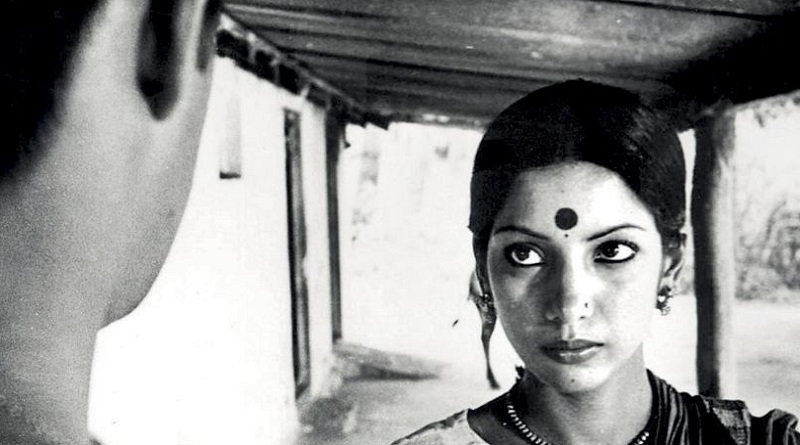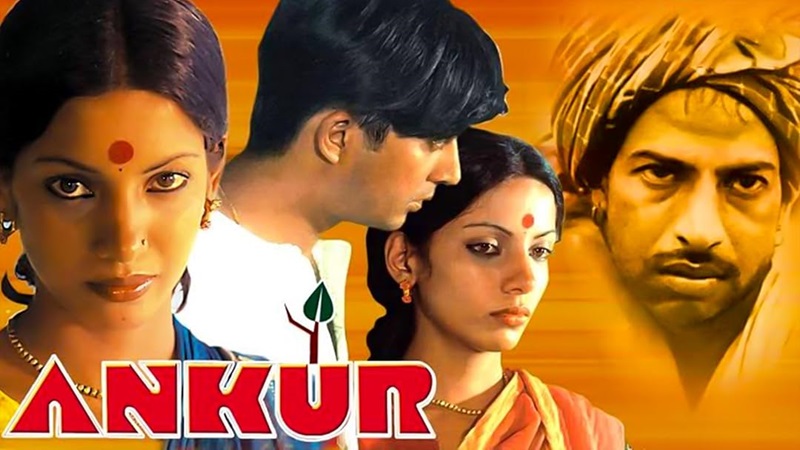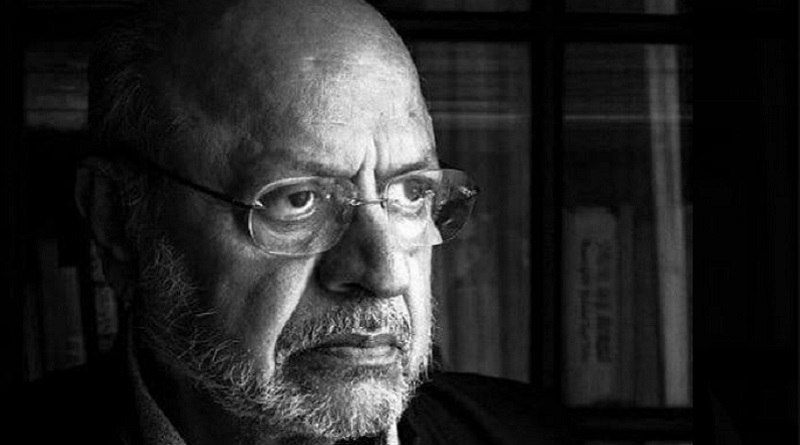Ankur movie: On 50th anniversary Shyam Benegal’s realistic depiction of Indian feudal society that exists till date

By Harsh Thakor
This year the Hindi film industry commemorates the 50th anniversary of Shyam Benegal’s first feature film, Ankur, released in 1974 which also marked the debut of Anant Nag and Shabana Azmi.
‘Ankur’ lit the first spark in the birth of art cinema. Shyam Benegal here explored new horizons in storytelling. Since Independence possibly no movie transcended realism of social oppression as poignantly. Remarkable that inspite of not being a conventional entertainer, it created magnetic effect on the audience.
Ankur was part of the Shyam Benegal trilogy with Nishant and Manthan, exploring the transition within India from the feudal systems that prevailed and continued to prevail.
Ankur was set in the background feudal oppression in the microcosmic rural world of a village in feudal state of Andhra Pradesh, in the 1945 period. It was shot in Hyderabad.
Significant the film was made in the background of major rebellion in India like Naxalbari movement, Jayaprakash Narayan movement, Dalit Panther uprising etc. It is filmed in the scenario of the 1970’s peasant rebellions, which gave it a cutting edge.
Today, after 50 years of its release, it’s theme is as relevant as ever movie with caste, class and gender elements still plaguing our society as rampantly. We need to resurrect such a film in a form relevant to modern times, incorporating effect of globalisation and advent of age of mechanisation and surge of religion revivalism.
We lost a gem in Indian film industry.
We are devastated by the passing away of Padma Shri #SadhuMeher sir, the National Award-winning actor, director, and producer of Indian film industry. #Sadhumeher #Ankur #Ankur (1974), #Abhilasha (1983) and #ByomkeshBakshi (1993). pic.twitter.com/ugG6tVe2pX
— Nishith sahasransu Ray (@nishithray8121) February 2, 2024
Merits of Movie
Brimming with energy and symbolism, Ankur is one of the most grounded and captivating Hindi social commentaries. It fuses a set of characters, exploring the intricacies of caste, class and gender in both rural and urban settings, in a most communicative manner.
Few Indian films ever as penetrative dug into the various characteristics interwoven to trigger feudal oppression or ignited the spirit of rebellion against feudal oppression, at such a scale. Macro forces of feudal power structures and gender oppression were immaculately illustrated.
Ankur pioneered a new style or forms in Hindi film making, introducing a style of naturalised acting and making actors dress in realistic costumes. Few films in Indian history epitomised experimentalism, to such an extent.
The languages used are the dialect of Dakhni Urdu, commonly used around Hyderabad. The blend of Dakhni and Telugu folk songs discovered new characters.
Unlike so many Hindi films, it lacks element of melodrama, projecting realism at the very core.
The strength of the film lies in the intensive exploration of characters and their motivations, the contradictory emotions they are dictated by, the stray glances and gestures, landscape details, soul searching use of folk music and natural sound.
Without political propaganda or polemics the movie conveys the social nature of feudal society and the aversion of people towards it.
In classical style Benegal has grafted and dissected the scenes, doing complete justice to the theme. The cinematography was executed with high finesse creating a heart pulling effect on the audience.
The direction of the cast and scenes exude a subtle touch of detachment, gripping an audience, but not letting it get carried away.
Important social issues of Indian society are organically interwoven in the narrative in to prevent the audience from being bored to the slightest. Macro forces of feudal power structures and gender oppression are illustrated.
In this movie, the very movements of artists convey the message as much as the dialogues, showing the mastery of the film maker .In the Brechtian manner it does ask the audience to respond without telling the viewer what to do.
The lack of singing and dancing gives this movie the crucial element of realism realistic edge that differentiates it from many others. From the chirping of the birds to the flow of the water, the sound effects were brilliantly affected, with use of natural sounds and traditional alaaps.
The abject submission of the oppressed to their lot is never projected for sympathy. However Benegal gives his characters time, reason and context to find their voices. With high craft movie illustrates how social conditions transpire inner change within people.
Aspect of sexuality is brilliantly fused with feudal oppression.
Brilliantly nuanced performances of both Shabana Azmi as Laxmi.and Anant Nag as Surya, with both complementing themselves in a perfect chemistry. Both immersed in the very thick of the skin of the characters, with inherent malleability and detachment, overcoming romanticism with realism, at a scale rarely touched on the silverscreeen. Nag instils realism with his sly looks, perfect mannerisms, and e deft touches. Azmi with subtle craft illustrates the struggle of an oppressed woman against bondage.
50th year of ANKUR. For me, it's Shyam Benegal's best film. I remember having watched it first at Regal theater in Delhi in 1974. And many more times after that. But once money got into his head, art and content took the back seat. pic.twitter.com/0aze5eiLdI
— Anirudhya Mitra (@AnirudhyaMitra3) November 28, 2023
Plot
Surya’s father has a mistress and a son in the village, both of whom are accepted even by Surya’s mother. The priest of the village hardly denotes that he is a man of God, yet holds a commanding position. An overseer is given free licence in broad daylight while Lakshmi is banished for stealing a few fistfuls of rice.
Surya, played by Anant Nag, is forced to relinquish higher studies to look after his father’s property. He has to shift to the village to take responsibility of the farms and crops. Before shifting, he gets married but leaves his wife behind. In the village, he falls in love with the domestic worker; Lakshmi played by Shabana Azmi and promises to take care of her forever, after her husband apparently deserts her.
Finally, Surya’s wife Saru played by the late social activist Priya Tendulkar returns to be with him in the village. Meanwhile, Lakshmi gets pregnant. Surya pleads her to abort the child because he cannot take the responsibility. She refuses to oblige him. Lakshmi’s husband Kishtayya played by Sadhu Meher, returns back to her at the conclusion of the movie and gives her the money that he earned, while he was away. He assumes that the baby is his and Lakshmi’s.
Features of Movie
In the film, Ankur, the villagers of the potter caste are cast to celebrate a separate festival for themselves. This segregation on the basis of caste is also demonstrated towards the concluding scene of the film when Kishtayya takes Lakshmi to their own village god’s temple, to pray for blessing them with a child.
Most illustratively it conveys how Industrialization brutally patronised exploitation of the working classes through Kishtayya, Lakshmi’s deaf and mute husband losing his job because the villagers now buy only aluminium vessels and not the ones made of mud or clay.
Surya hypocritically claims that he opposes the caste system, but in practice his attitudes and behaviour convey the diametric opposite. The villagers are consistently projected to bow down to his dictates. They always salute him and the local police Sheikh Chand, also lights the cigarette for him.
In symmetric form division of labour is illustrated amongst the barber, farmers and priest. The only aspect of system he breaks is when he orders Lakshmi of the potter Dalit caste to cook for him, instead of the priest. Nevertheless, he always keeps her in her stranglehold and shows sexual interest towards her, as is clearly indicated by his male gaze. Thus, he ultimately exploits and oppresses her, both on the basis of caste and gender.
The village head forces Rajamma, who wanted a divorce from her impotent husband, to go back to him. Further, he scolds her for having relationship with a man from another village and caste. He also emphasises that a woman does is not only the property of her husband but the entire household, caste and community. So, even if her husband cannot fulfil her, the brother in laws can replace them. Thus it implies that a woman has to passively submit t in any sexual relationship.
The festival of Diwali is portrayed as the ultimate weapon of capitalist exploitation. The poor village children could barely witness of the display of sheer pomp and wealth by Surya. On the eve of Diwali, he engages in gambling and drinking with other upper caste men of the village with one of the men even placing s his wife at stake.
Ankur (Shyam Benegal, 1974) https://t.co/Vo0cMKrmuj pic.twitter.com/gPUjdyL9aa
— AᴀKɪꜰ (@SalmanFan4Ever_) May 29, 2024
A most captivating scene when Surya shows scorn on the workers tilling the land, asserting his superior stature in the hierarch.
The abject submission of the oppressed to their lot is never projected for sympathy. However Benegal gives his characters time, reason and context to find their voices.
A heart touching and defining moment is when Lakshmi intensely narrates the tragic circumstances of her marriage to Kishtaya, whose profession as a skilful potter , thanks due is quashed to advent and demand for aluminium ware.
Secretly, Lakshmi is thirsty for sexual fulfillment and although berates Kishtaya for his drunkenness cares for Kishtaya as she would had contempt for her master’s scorn at Kishtaya’s worthlessness.
It is heart touching to witness the gripping scenes reflecting sheer inner metamorphosis in Laxmi after being tormented by Surya’s wife and the dramatic change in attitude towards Kshitaya towards the end. Most poignant scenes of Surya’s wife rebuking Laxmi,on caste grounds.
Lakshmi, enacted by Shabana Azmi with the contrasting effect of a camelion expresses a wide range of conflicting emotions, be it relief and despair, trust and guilt. Her crystallisation from a submissive woman into one determined to combat the shackles of oppression to the very end epitomises social forces triggering rebellion in truly classical style.
In Ankur, it is a nameless child, who symbolises the voice of justice. He screams to Surya about Kishtaya stealing from the fields who is shaved and then paraded around the village on a donkey – and at the end of the film, it is the very same child who metaphors the struggle against the bondage of the landlord and his kind.
Ankur’s climax is a powerful statement of the awakened consciousness of the oppressed peasants. A young boy flinging a stone across Surya’s home manifests the rebellious spirit of the younger generation. A striking dicthonomy is reflected of the enthusiasm of the people to protest injustice with the fear lying within them. I have seen few films with the ending projected in such a subtle manner.
Ankur (Shyam Benegal, 1974) pic.twitter.com/FsSSsY6lRd
— Jessica (@Jessyinchains) May 30, 2020
Issues highlighted
Issues raised are mainly Alcoholism, Adultery, Casteism and divide between rich and poor.
Lakshmi works extremely hard for earning an honest living but her husband’s alcoholism and the meager pay that she receives provokes her to steal rice from Surya’s house. It is his alcoholism that ultimately results in his downfall when he is reprimanded by Surya.
Issue of casteism is brought out frequently in discussions between different characters. Lakshmi is an untouchable and when Surya employs her to cook his food, it arouses unrest in the entire village. When Surya’s wife comes to live with him, she refuses to eat anything from Lakshmi’s hands and gradually throws her out of the house.
Disparity between the rich and the poor .is projected with high effect. While Lakshmi has to grind hard to eke out a living and steals rice just to make ends meet, the landlords live or benefiting out of the hard work that the others put in in their fields.
The entire village abhors Surya for his attitude and behaviour towards them but lack the guts to resist him. Lakshmi gradually gets so entrapped or helpless because of her poverty and her husband’s sudden disappearance that she is virtually forced to fall into the arms of Surya.
Surya and Lakshmi are both guilty of committing adultery with different reasons.Surya is frustrated because of a lack of sexual satisfaction.
(Harsh Thakor is a freelance journalist. Thanks information from article by Sangeeta Datta in the Scroll . in Medium by Amna Khan, Upasan Goswami in feminism.india and article by Ambar Chaterjee)
Do read also:-
- Gig workers: Regulating Work Platforms, exposing Algorithms
- Labour in ‘Amrit Kaal’ : A reality check
- Discovering the truth about Demonetisation, edited and censored, or buried deep?
- Class Character of a Hindu Rashtra- An analysis
- Gig Workers – Everywhere, from India to America, from delivery boys to University teachers
- May Day Special: Working masses of England continue to carry the spirit of May Day through the Year
- New India as ‘Employer Dreamland’
- Urgent need for reinventing Public Sector Undertakings
Subscribe to support Workers Unity – Click Here
(Workers can follow Unity’s Facebook, Twitter and YouTube. Click here to subscribe to the Telegram channel. Download the app for easy and direct reading on mobile.)




